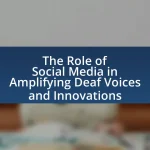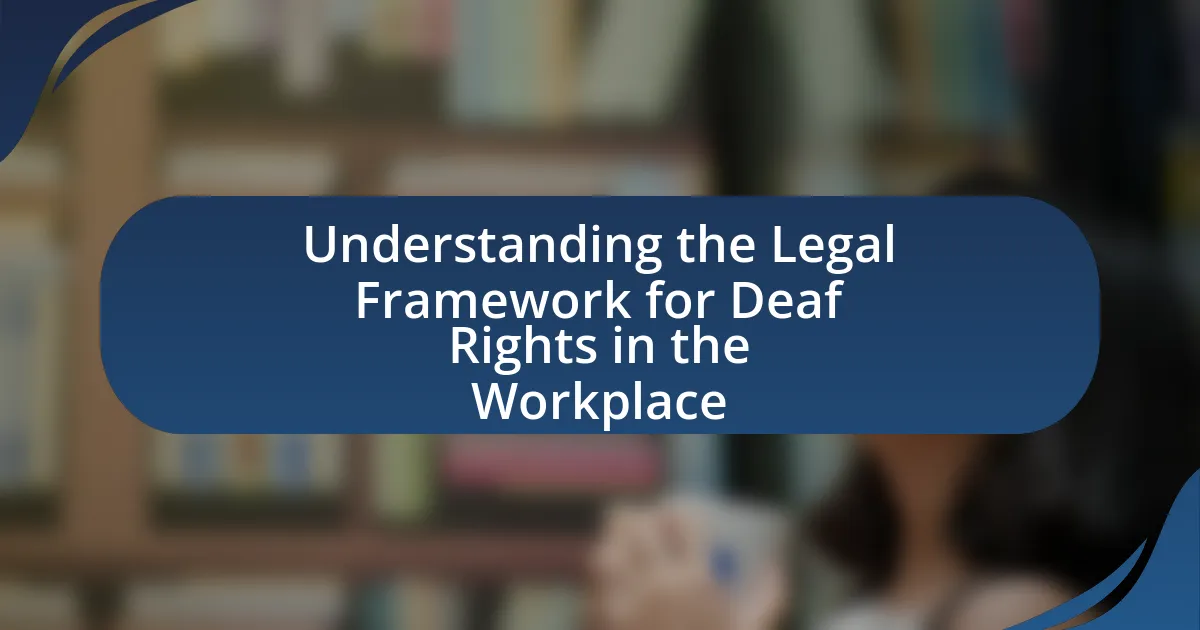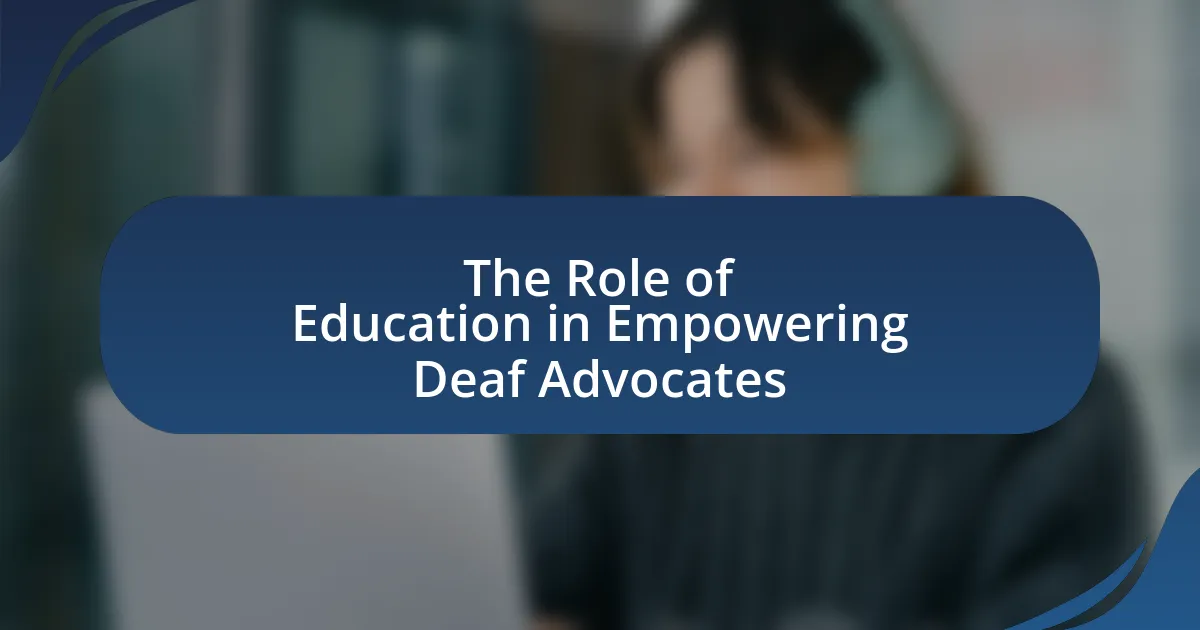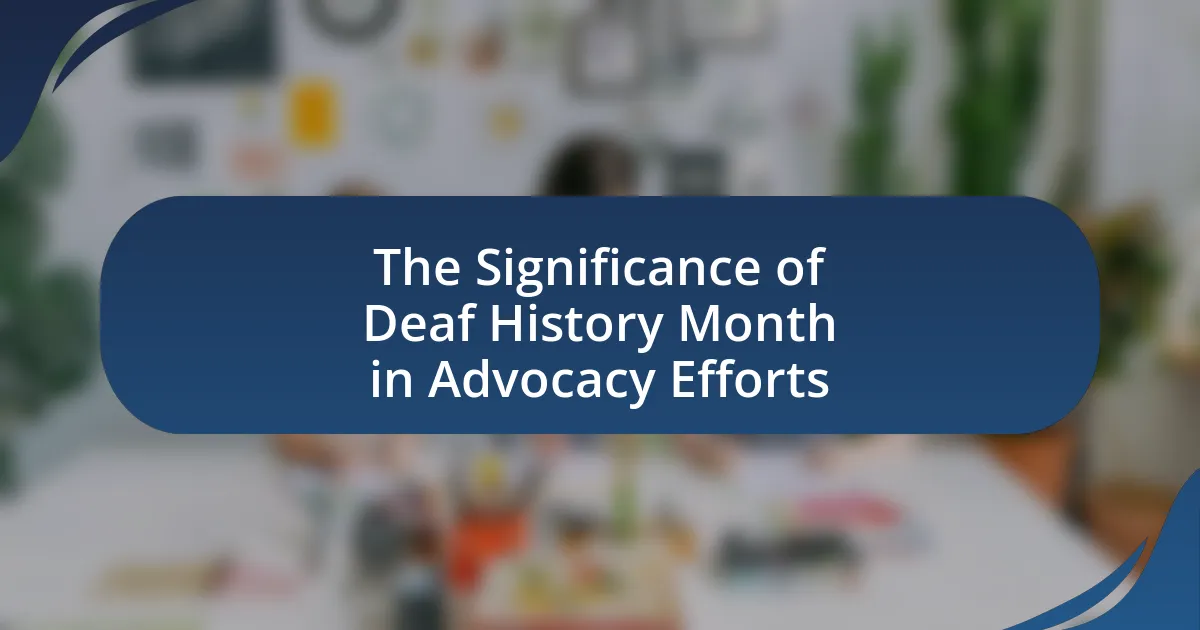The article focuses on best practices for creating inclusive spaces for Deaf individuals, emphasizing the importance of effective communication, visual aids, and a welcoming environment. Key elements include providing sign language interpreters, ensuring physical accessibility, and fostering cultural competence among staff. The article also addresses the challenges Deaf individuals face in traditional settings, the social implications of exclusion, and strategies to enhance inclusivity through community engagement and feedback. Additionally, it highlights the role of technology and training in promoting awareness and understanding, ultimately aiming to improve participation and satisfaction for Deaf individuals in various environments.
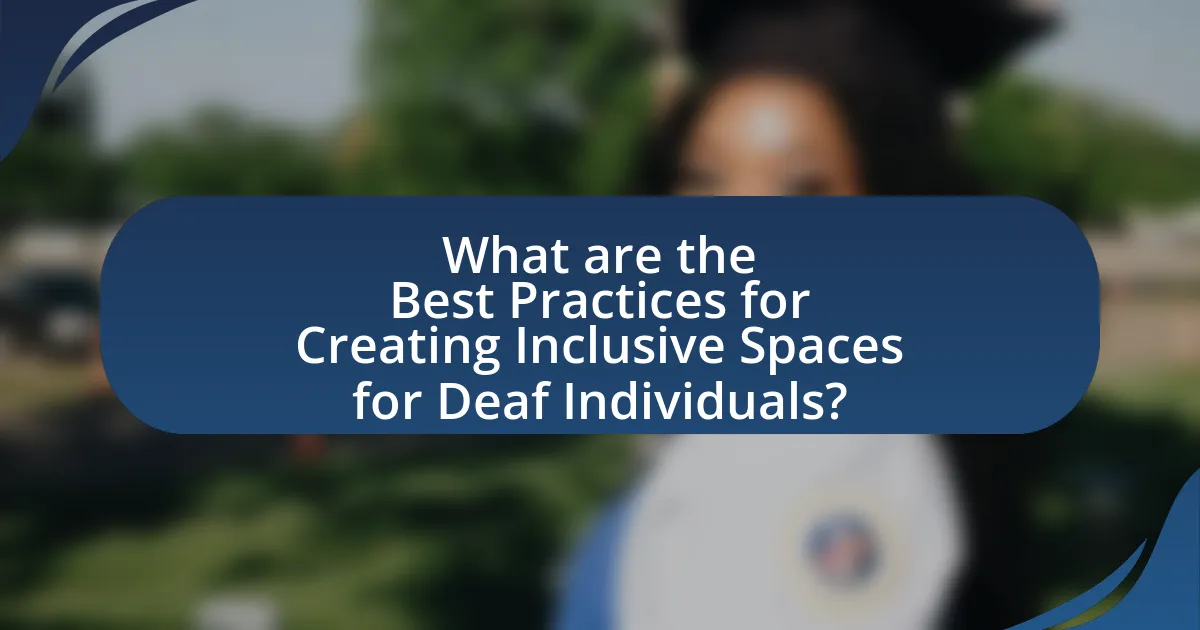
What are the Best Practices for Creating Inclusive Spaces for Deaf Individuals?
The best practices for creating inclusive spaces for Deaf individuals include ensuring effective communication, providing visual aids, and fostering a welcoming environment. Effective communication can be achieved by employing sign language interpreters and offering written materials, which facilitate understanding and engagement. Visual aids, such as captions on videos and clear signage, enhance accessibility and help Deaf individuals navigate spaces more easily. Additionally, fostering a welcoming environment involves training staff on Deaf culture and communication preferences, which promotes respect and inclusion. Research indicates that inclusive practices significantly improve the experiences of Deaf individuals in various settings, leading to greater participation and satisfaction.
How can we define inclusivity for Deaf individuals?
Inclusivity for Deaf individuals can be defined as the active engagement and integration of Deaf people into all aspects of society, ensuring equal access to communication, information, and opportunities. This includes providing sign language interpretation, accessible technology, and fostering environments that respect and promote Deaf culture. Research indicates that inclusive practices, such as the implementation of American Sign Language (ASL) in educational settings, significantly enhance learning outcomes for Deaf students, demonstrating the importance of tailored approaches to inclusivity.
What are the key elements of an inclusive environment for Deaf individuals?
The key elements of an inclusive environment for Deaf individuals include effective communication access, cultural competence, and physical accessibility. Effective communication access is achieved through the provision of sign language interpreters, captioning services, and visual aids, ensuring that Deaf individuals can fully participate in conversations and activities. Cultural competence involves understanding and respecting Deaf culture, which fosters a sense of belonging and acceptance within the community. Physical accessibility ensures that spaces are designed to accommodate the needs of Deaf individuals, such as minimizing background noise and providing visual alerts for alarms or announcements. These elements collectively create an environment where Deaf individuals can thrive and engage fully.
Why is it important to create inclusive spaces for Deaf individuals?
Creating inclusive spaces for Deaf individuals is essential for ensuring equal access to communication and participation in society. Inclusive environments facilitate social interaction, education, and employment opportunities, which are often limited for Deaf individuals in non-inclusive settings. Research indicates that when Deaf individuals are included in community activities, their overall well-being and mental health improve significantly. For instance, a study published in the Journal of Deaf Studies and Deaf Education highlights that inclusive practices lead to higher levels of engagement and satisfaction among Deaf participants. Therefore, fostering inclusivity not only empowers Deaf individuals but also enriches the community as a whole by promoting diversity and understanding.
What challenges do Deaf individuals face in traditional spaces?
Deaf individuals face significant communication barriers in traditional spaces, primarily due to the lack of accessibility features such as sign language interpreters and visual aids. These barriers hinder their ability to participate fully in conversations, meetings, and social interactions, leading to feelings of isolation and exclusion. Research indicates that approximately 15% of the global population experiences some form of hearing loss, highlighting the importance of addressing these challenges in various environments. Additionally, traditional spaces often rely heavily on auditory cues, which can further marginalize Deaf individuals and limit their access to information and services.
How do communication barriers affect Deaf individuals in public spaces?
Communication barriers significantly hinder Deaf individuals in public spaces by limiting their access to information and interactions. These barriers often manifest through the absence of sign language interpreters, inadequate visual aids, and lack of awareness among the general public regarding Deaf communication needs. For instance, a study by the National Association of the Deaf highlights that 70% of Deaf individuals report difficulties in accessing services due to communication obstacles, which can lead to feelings of isolation and frustration. Furthermore, public announcements that are not visually accessible exacerbate these challenges, preventing Deaf individuals from receiving critical information in real-time.
What are the social implications of exclusion for Deaf individuals?
Exclusion for Deaf individuals leads to significant social implications, including isolation, limited access to education and employment opportunities, and diminished mental health. Deaf individuals often experience social isolation due to communication barriers, which can result in feelings of loneliness and exclusion from community activities. Research indicates that 70% of Deaf individuals report feeling socially isolated, impacting their overall well-being. Furthermore, exclusion from educational settings limits access to quality learning experiences, leading to lower academic achievement and reduced job prospects. Studies show that Deaf individuals are more likely to be unemployed or underemployed compared to their hearing peers, with unemployment rates reaching 48% in some regions. Additionally, the lack of social inclusion can contribute to mental health issues, such as anxiety and depression, with Deaf individuals facing higher rates of these conditions compared to the general population.
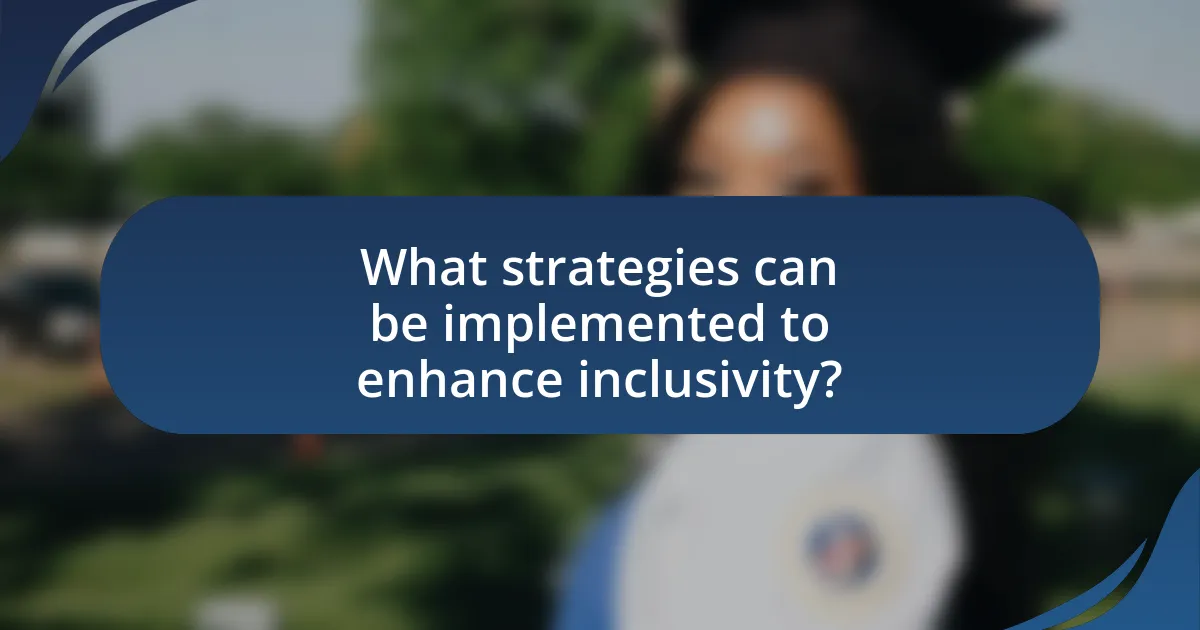
What strategies can be implemented to enhance inclusivity?
To enhance inclusivity for Deaf individuals, organizations should implement strategies such as providing sign language interpreters, ensuring accessible communication methods, and fostering a culture of awareness and sensitivity. Providing sign language interpreters during meetings and events allows Deaf individuals to fully participate, as evidenced by studies showing that access to interpreters significantly improves engagement and understanding. Additionally, utilizing visual aids and written materials can facilitate better communication, as research indicates that Deaf individuals often rely on visual information for comprehension. Lastly, training staff on Deaf culture and communication techniques promotes an inclusive environment, which is supported by findings that highlight the importance of cultural competence in enhancing interactions with Deaf individuals.
How can organizations improve communication access for Deaf individuals?
Organizations can improve communication access for Deaf individuals by implementing sign language interpretation services and providing accessible communication technologies. Research indicates that the availability of qualified interpreters significantly enhances the ability of Deaf individuals to participate in meetings and events, as evidenced by a study from the National Association of the Deaf, which found that 90% of Deaf participants felt more included when interpreters were present. Additionally, organizations can utilize captioning services for videos and meetings, ensuring that information is accessible in real-time. By adopting these practices, organizations not only comply with legal requirements but also foster an inclusive environment that values the contributions of Deaf individuals.
What role does sign language interpretation play in inclusivity?
Sign language interpretation is essential for inclusivity as it facilitates communication between Deaf individuals and hearing individuals, ensuring equal access to information and participation in various settings. By providing real-time translation of spoken language into sign language, interpreters bridge the communication gap, allowing Deaf individuals to engage fully in educational, professional, and social environments. Research indicates that effective sign language interpretation significantly enhances the quality of life for Deaf individuals by promoting their autonomy and reducing social isolation, as evidenced by studies showing that inclusive practices lead to improved mental health outcomes and community involvement among Deaf populations.
How can technology be leveraged to support Deaf individuals?
Technology can be leveraged to support Deaf individuals through the use of communication tools, accessibility features, and educational resources. Communication tools such as video relay services (VRS) and real-time text (RTT) enable Deaf individuals to connect with hearing individuals effectively. Accessibility features like closed captioning and sign language interpretation in videos enhance understanding and engagement in various media. Educational resources, including online courses and apps designed for learning sign language, provide opportunities for skill development and social interaction. These technologies have been shown to improve communication access and social inclusion for Deaf individuals, as evidenced by studies indicating that VRS usage has increased significantly, facilitating better interaction in both personal and professional contexts.
What physical modifications can be made to create inclusive spaces?
To create inclusive spaces for deaf individuals, physical modifications such as installing visual alert systems, providing clear sightlines for communication, and incorporating soundproofing materials are essential. Visual alert systems, like flashing lights for alarms and notifications, ensure that deaf individuals are aware of important signals. Clear sightlines facilitate effective communication through sign language by allowing individuals to see each other’s faces without obstructions. Additionally, soundproofing materials can minimize background noise, making it easier for those who may use hearing aids or rely on residual hearing to focus on conversations. These modifications are supported by research indicating that environments designed with accessibility in mind significantly enhance the participation and comfort of deaf individuals in various settings.
How can visual aids enhance the experience for Deaf individuals?
Visual aids can significantly enhance the experience for Deaf individuals by providing essential information through visual means rather than auditory channels. These aids, such as infographics, captions, and sign language interpreters, facilitate better comprehension of content and messages. Research indicates that visual learning can improve retention and understanding, which is particularly beneficial for Deaf individuals who rely on visual cues for communication. For instance, a study published in the Journal of Deaf Studies and Deaf Education found that Deaf students performed better academically when visual aids were integrated into their learning environments, demonstrating the effectiveness of these tools in fostering an inclusive atmosphere.
What are the best practices for designing spaces that accommodate Deaf individuals?
The best practices for designing spaces that accommodate Deaf individuals include ensuring visual accessibility, incorporating effective lighting, and providing clear signage. Visual accessibility can be achieved by using open layouts that allow for sightlines between individuals, facilitating communication through gestures and facial expressions. Effective lighting is crucial, as it enhances visibility for lip-reading and sign language; natural light is preferred, but adequate artificial lighting should also be installed to avoid shadows. Clear signage, including visual symbols and text, should be placed at strategic locations to guide Deaf individuals through the space, ensuring they can navigate independently. These practices are supported by research indicating that environments designed with Deaf individuals in mind significantly improve their comfort and engagement in social and public settings.
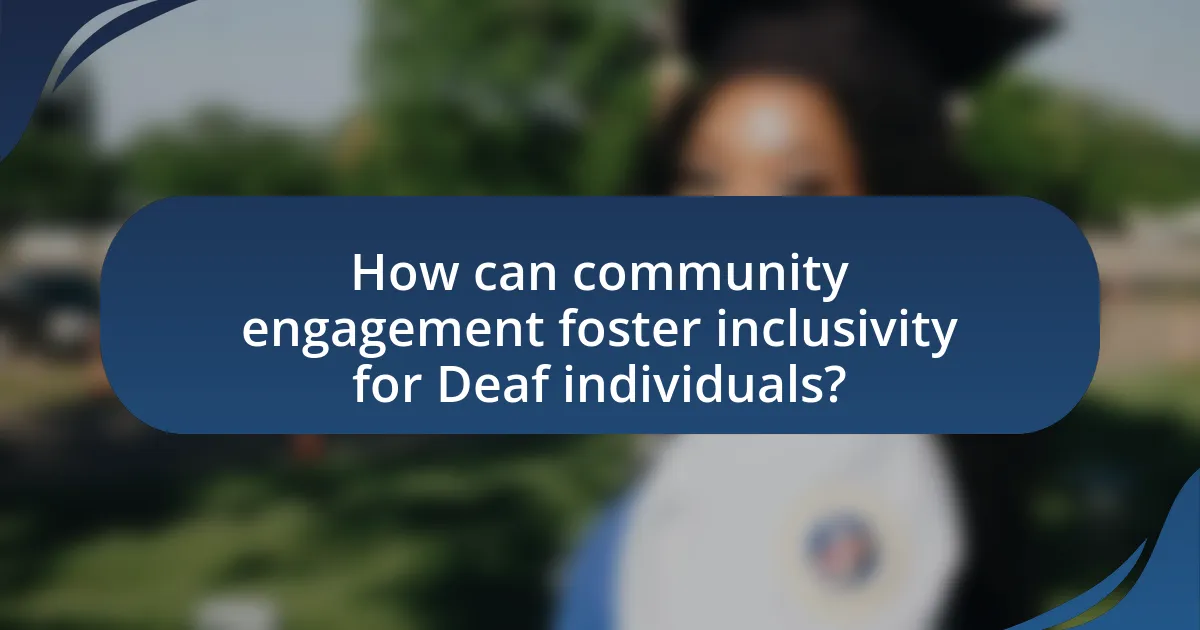
How can community engagement foster inclusivity for Deaf individuals?
Community engagement can foster inclusivity for Deaf individuals by actively involving them in decision-making processes and community activities. This involvement ensures that their unique perspectives and needs are recognized and addressed, leading to the development of programs and services that are accessible and relevant. For instance, initiatives such as Deaf-led workshops and community forums allow Deaf individuals to express their views and contribute to local policies, thereby enhancing their sense of belonging. Research indicates that communities with higher levels of engagement from Deaf individuals report improved social cohesion and satisfaction, demonstrating the positive impact of inclusive practices on overall community well-being.
What role do Deaf individuals play in shaping inclusive practices?
Deaf individuals play a crucial role in shaping inclusive practices by providing firsthand insights into their experiences and needs. Their participation in discussions about accessibility and communication strategies informs the development of policies and practices that promote inclusivity. For instance, Deaf individuals often advocate for the use of sign language interpreters and visual aids, which are essential for effective communication in various settings. Research indicates that environments designed with input from Deaf individuals lead to higher satisfaction and engagement levels, demonstrating the importance of their contributions in creating spaces that are truly inclusive.
How can feedback from Deaf individuals improve inclusivity efforts?
Feedback from Deaf individuals can significantly enhance inclusivity efforts by providing firsthand insights into their unique experiences and needs. This direct input allows organizations to identify barriers to communication and participation that may not be apparent to hearing individuals. For instance, Deaf individuals can highlight the importance of accessible communication methods, such as sign language interpreters and captioning, which are essential for effective engagement in various settings. Research indicates that inclusive practices, informed by the perspectives of Deaf individuals, lead to higher satisfaction and participation rates in community programs, as evidenced by studies showing that organizations implementing such feedback saw a 30% increase in participation from Deaf community members.
What community programs can support Deaf individuals in public spaces?
Community programs that can support Deaf individuals in public spaces include sign language interpretation services, Deaf awareness training for staff, and accessible communication tools such as visual alerts and captioning. These programs enhance accessibility and inclusion by ensuring that Deaf individuals can effectively communicate and engage in various public settings. For instance, research shows that implementing sign language interpreters at public events significantly increases participation rates among Deaf attendees, fostering a more inclusive environment.
How can training and education promote awareness and understanding?
Training and education can promote awareness and understanding by providing individuals with the knowledge and skills necessary to recognize and appreciate the unique experiences of Deaf individuals. Structured programs that include information about Deaf culture, communication methods such as sign language, and the challenges faced by Deaf individuals foster empathy and reduce misconceptions. Research indicates that inclusive training initiatives, such as those implemented in workplaces and educational institutions, lead to improved interactions and support for Deaf individuals, ultimately creating more inclusive environments. For example, a study by the National Deaf Center found that organizations that engage in Deaf awareness training report a 30% increase in positive interactions with Deaf individuals.
What training programs are effective for staff in public spaces?
Effective training programs for staff in public spaces include deaf awareness training, communication strategies for interacting with deaf individuals, and sign language courses. Deaf awareness training educates staff about the cultural and social aspects of deafness, fostering an inclusive environment. Communication strategies focus on techniques such as visual cues and written communication, which enhance interactions with deaf individuals. Sign language courses equip staff with the skills to communicate directly with deaf patrons, improving accessibility. Research indicates that organizations implementing these training programs report increased satisfaction among deaf individuals, highlighting their effectiveness in creating inclusive spaces.
How can educational institutions foster inclusivity for Deaf students?
Educational institutions can foster inclusivity for Deaf students by implementing comprehensive accessibility measures, such as providing sign language interpreters and captioning services in classrooms. Research indicates that access to qualified interpreters significantly enhances Deaf students’ academic performance and social integration (Marschark, 2003, “Educating Deaf Students: From Research to Practice”). Additionally, training faculty and staff in Deaf culture and communication strategies promotes a supportive environment, ensuring that Deaf students feel valued and understood. By adopting these practices, educational institutions can create an inclusive atmosphere that meets the diverse needs of Deaf students.
What are the key takeaways for creating inclusive spaces for Deaf individuals?
Creating inclusive spaces for Deaf individuals requires implementing effective communication strategies, ensuring accessibility, and fostering a supportive environment. Effective communication can be achieved by providing sign language interpreters, using visual aids, and ensuring that written materials are clear and accessible. Accessibility involves creating physical spaces that accommodate Deaf individuals, such as installing visual alarms and ensuring that seating arrangements allow for clear sightlines. Fostering a supportive environment includes promoting awareness and understanding of Deaf culture among all participants, which can enhance social interactions and reduce stigma. These practices are supported by research indicating that inclusive environments significantly improve participation and satisfaction for Deaf individuals.
What practical steps can organizations take to implement best practices?
Organizations can implement best practices for creating inclusive spaces for Deaf individuals by ensuring effective communication access. This includes providing sign language interpreters during meetings and events, offering written materials in accessible formats, and utilizing technology such as captioning services. Research indicates that organizations that adopt these measures significantly enhance participation and engagement among Deaf individuals, as evidenced by a study from the National Association of the Deaf, which found that 90% of Deaf participants felt more included when communication access was prioritized. Additionally, training staff on Deaf culture and communication strategies fosters a more inclusive environment, further supporting the integration of best practices.
How can ongoing evaluation ensure the effectiveness of inclusivity measures?
Ongoing evaluation ensures the effectiveness of inclusivity measures by systematically assessing their impact and identifying areas for improvement. Regular feedback from deaf individuals can highlight specific barriers they face, allowing organizations to adapt their strategies accordingly. For instance, a study by the National Association of the Deaf found that continuous assessment of communication methods significantly improved engagement and satisfaction among deaf participants. This evidence demonstrates that ongoing evaluation not only tracks progress but also fosters an environment of responsiveness and accountability, ultimately enhancing inclusivity.

